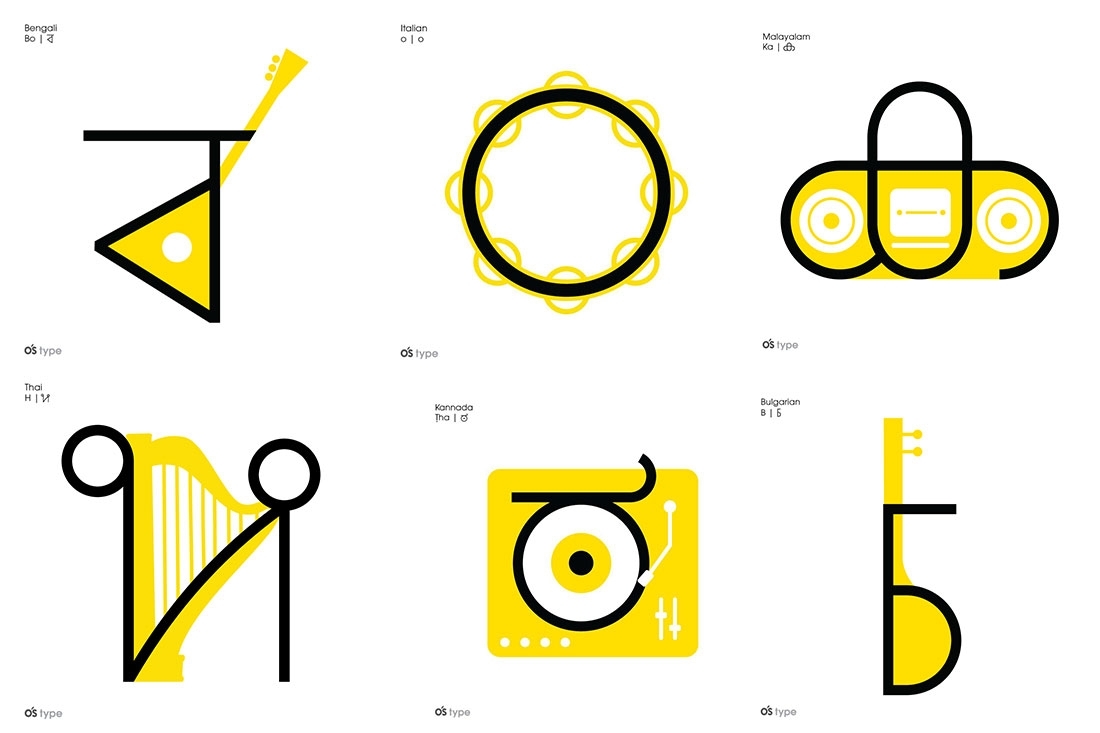
The Mother Tongue Project Creatives

The Mother Tongue Project Creatives
Language, more often than not, has been the dividing factor in the history of human civilisation. With the language changing from one country to another and in case of India, from one state to another, it is often difficult to accept this diversity as a unifier of sorts. The Mother Tongue Project—an instagram art initiative—is trying to change just that.
An ongoing 30-day celebration of languages through the month of November, The Mother Tongue Project is an initiative of One September. Co-founded by Jnana Prasanna Kumar Sarvasiddi, who commonly goes by the moniker JPAX, The Mother Tongue Project is an attempt to convey that each language, whether or not universal in its growth, is as beautiful as the sound of music. An interesting fusion of type, design and linguistics, the project blends letters from different languages with the shapes of various musical instruments and objects.
Known for his previous work like The Seesaw Project that sheds light on the existing gender inequality and misogyny in the society, JPAX is the co-curator of The Mother Tongue Project, working in association with his colleague Parth. We speak to him about the inspiration of his latest project.
The Mother Tongue Project combines art and linguistics.
The Mother Tongue Project is a One September Labs (aka OS Labs) initiative. We like to experiment with a lot of ideas. It was born out of a simple insight that every language is as beautiful as music. Parth, our designer, is my partner on this project. It runs through the month of November on Instagram.

You still speak in your mother tongue, Telugu.
I was born in a Telugu family and yes, we speak in our mother tongue even today but I’ve personally observed that people have stopped talking in their native language because they feel shy or ashamed of it. This disparity towards one’s mother tongue was a predominant motivator behind this project.
Also, the change in the sound, slang, dialect, and meaning of words in the same language within a few kilometres of travelling in the same state is what fascinated me. It changes every 90-100 kms.
Your creative process.
Once we were ready with the concept, we started thinking of different ways to bring out the blend of music and letters together in a clutter free manner. The first step was to identify the languages and once we had a good number of them, we started experimenting with the musical instruments. We used two colours; black for the letter and school bus yellow for the musical instrument. We didn’t want a regional musical instrument association with the letter. We only wanted to build a mental association with music.
The challenge was to look out for the common form, for both the letters and the musical instruments. Even if one of them didn’t fit well, we dropped it and moved on to the next one. Parth would sit, scan each letter, get the right meaning of the letter, find the perfect fit, along with the history of the letter etc. Across all the designs we maintained the same stroke thickness and style for the musical instruments to sustain uniformity.
Your thoughts on what the project aims to achieve.
Every language is beautiful in its own way. We might be using a standard language for functionality and comprehension. But that, in no way, should lead to a comparison of languages. Because at the end of the day, a language is technically a sound. And we’ve given it structure, form and meaning for our convenience. The Mother Tongue Project is also an attempt to convey that every language is as beautiful as music. People like music not because of the region/race/language it belongs to. They love the sound of it. That's what we wanted to highlight in this project by taking letters from different languages and blending it with the shapes of various musical instruments and objects which are music related.
When we were researching different languages and their alphabets, we came across Manipuri. I fell in love with the Manipuri alphabet. They are so beautiful. Each letter looks like a logo. It was really hard for me to pick a letter and work on because every letter looked great. And this was a personal discovery, which, both Parth and I experienced. He thought Burmese was created by aliens. He was amused by the letter form.
The Seesaw Project
The Seesaw Project, co-founded by JPAX in association with Sakshi and Burzin, hopes to simplify the complex interpretations of gender bias with a simple universal language - Art. Just like the way a seesaw tilts to one side, the current world is tilted to one side—patriarchy. We want to bring the seesaw to a straight line where are all the genders co-exist happily without any inequalities.
When Parth was doing the research for Mandarin characters for The Mother Tongue Project, we found that the Mandarin character for ‘female’ was originally a woman kneeling on the floor, showing obedience to her man. And to our shock there are more characters like this. And Mandarin Chinese is 3000 years or older. Imagine the impact of it over the generations! And this sexism in language exists in other languages too.

The Future
Currently, there are a lot of experiments that are going on at OS Labs in the areas of illustration, video editing, AI, photography, web design, collage mix, typography, films, animation etc. You can definitely look out for one more project that Parth and I are working. Hopefully, it’s going to release very soon.
You can follow the project on @oneseptember and check out more work on www.oneseptember.in
Text Pankhuri Shukla